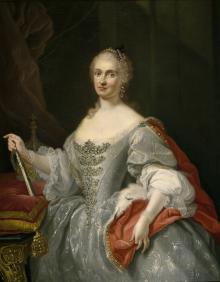You are here
Maria Amalia

Maria Amalia, Queen of the Two Sicilies (24 November 1724 – 27 September 1760), was born in Dresden in 1724, the daughter of Friedrich August II, Elector of Saxony. On the death of her grandfather, the charismatic monarch August the Strong, who reigned as August II of Poland from 1697-1733, her father was elected king of Poland and took the name August III. In 1738 Maria Amalia married Carlo VII, the first Bourbon king of the Two Sicilies. He was the son of Philip V of Spain and, in 1759, he succeeded his father as Carlos III, king of Spain. Maria Amalia therefore became queen of Spain, though for only one year until her death. Her lineage was important for the ruler of this new kingdom. On her mother’s side, she was the grand-daughter of the Habsburg Emperor Joseph I and, seeing that Carlos had retaken Naples from the Austrians as recently as 1732, the marriage represented a rapprochement between Habsburgs and Bourbons. Maria Amalia was also a Wettin, the descendant of a dynasty traceable to the tenth century, which had ruled in Dresden since the late fifteenth century. Though only thirteen years old when she left Dresden to meet, for the first time, the man she had already been married to by proxy before she left, the marriage was a happy one and Carlos grieved greatly at her death and never married again.
The primary duty of a consort is to produce a male heir. In Maria Amalia’s case, this took some time. By the age of 23 and after 9 years of marriage she had given birth to five daughters, two of whom were already dead. Finally in 1747 she bore her first son, Felipe Pascual, whose arrival was celebrated in Naples for a full fortnight in the most lavish manner possible. Felipe turned out, however, to be mentally handicapped and had eventually to be set aside as heir to the throne of the Two Sicilies. Fortunately, however, Maria Amalia had given birth after him to a further five boys and two girls, so there was no problem in finding a substitute. His next brother became Carlos IV, King of Spain, leaving the way clear for his second next brother to become Ferdinand I, King of the Two Sicilies.
Maria Amalia came from a highly cultured court: her father was a real connoisseur of music, especially Italian opera, and there was frequent exchange of composers and musicians between Naples and Dresden, for instance, Johann Adolf Hasse (1699-1783) and Nicolo Porpora (1686-1668). She herself had an excellent musical education. Her father was also a conoisseur of art and antiquities and it was he who acquired some of the most famous works in the Dresden picture collection today. During her time in Naples, the Royal Palace was improved and remodelled and the palaces of Capodimonte, Portici and Caserta were either completed or begun. The remains of Pompeii and Herculaneum were excavated under the patronage of the royal couple and music at the San Carlo opera house was at a high level. We have only to think of the invitation to Johann Willibald Gluck (1714-87) in 1752.
Maria Amalia brought a porcelain wedding service with her to Naples and received various other gifts of porcelain from her parents during her time there. The secret of hard-paste porcelain had been discovered in Dresden in 1708 and a porcelain factory had been established in Meissen in 1710. In emulation of Meissen, a porcelain factory was founded at Capodimonte, even though the craftsmen there were only able to make soft-paste porcelain. When Carlo and Maria Amalia left for Spain, they closed the factory in Naples, taking everything with them, and founded the porcelain factory of Buen Retiro in Madrid.
Areas of Research:
- Cultural Influence:
- What was Maria Amalia’s educational, artistic and religious formation in Dresden? What were her on-going contacts with her birth family?
- What were the expectations she was expected to fulfill as Queen of the Two Sicilies and, in the last year of her life, as Queen of Spain?
- What artistic influences did she bring with her to Naples?
- How involved was she in the highly-developed musical life of Naples?
- What was her role in the design of the new palaces and in the excavations at Pompeii and Herculaneum?
- Was she a conduit for Neapolitan influence in Dresden?
- What was her role in the religious life of the court?
- National cultural memory:
- Whoever visits Naples or Caserta today finds Maria Amalia’s daughter-in-law Maria Carolina of Austria remembered everywhere. Why are the twenty years of Maria Amalia’s sojourn in Naples so frequently glossed over, especially when these are the founding decades of the Bourbon monarchy of the Two Sicilies?


